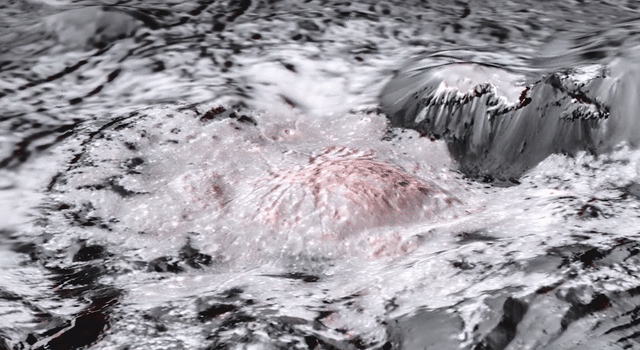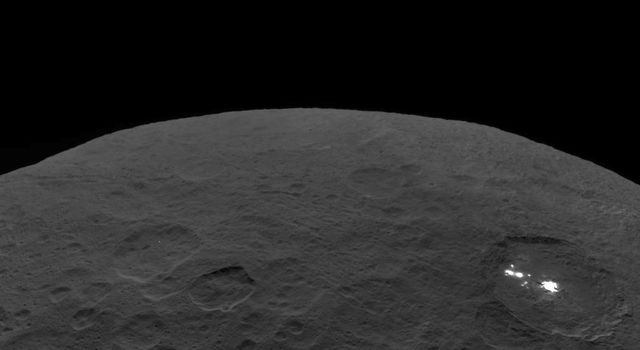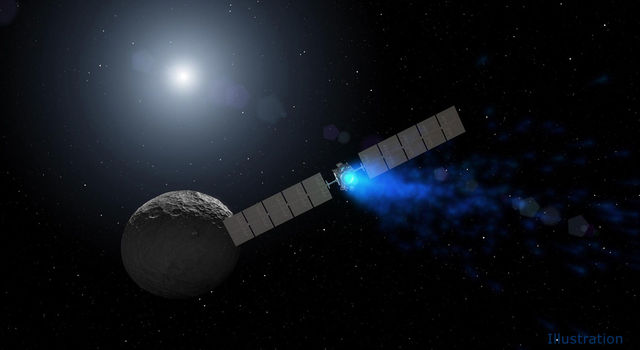Blogs | Dawn Journal | June 30, 2018
Dear Phendawnmenal Readers,
Dawn is going out on a high! Or maybe a low. Rapidly nearing the end of a unique decade-long interplanetary expedition, Dawn is taking phenomenal pictures of dwarf planet Ceres as it swoops closer to the ground than ever before. While the pictures are too new for compelling scientific conclusions to be reached, a clear consensus has already emerged: Wow!!!
Every 27 hours, the bold adventurer plunges from 2,500 miles (4,000 kilometers) down to just 22 miles (35 kilometers) above the alien world, accelerating to 1,050 mph (1,690 kph), and then shoots back up to do it all over again. (Try that, bungee jumpers!)
When Dawn dives low, it takes spectacular pictures, and you can see some of them here and more in the image gallery. But that's not all it does. The spacecraft also collects a trove of data on the nuclear radiation emanating from Ceres (which can reveal some of the atomic elements that are present), the gravity field (which can reveal the distribution of mass underground) and the infrared and visible light (which can reveal the minerals on the ground). Dawn has made all these kinds of measurements before, not only during more than three years at Ceres, the largest object in the main asteroid belt, but also during its 2011-2012 studies of Vesta, the second largest. But prior to this month, Dawn had never been this close and so never had such breathtaking sights and never been able to gather such high-resolution information.
We described the nature of this orbit in the three previous Dawn Journals. It is known as extended mission orbit 7 (XMO7) because Dawn's computer program for generating really cool and dramatic names was offline when it was time to come up with the name. Ever resourceful, the team activated the backup software that generates accurate but uninspiring names.
That kind of resourcefulness has served Dawn very well. Despite critical hardware failures that could have been disastrous for the mission, the flight team has accomplished success after success. The difficulty of flying so low -- only three times your altitude when you travel in a commercial jet -- and actually collecting useful data there seemed unachievable as recently as late last year. And now Dawn is doing it regularly.

Before XMO7, the spacecraft's lowest orbit around Ceres was 240 miles (385 kilometers), about the same height as the International Space Station is above Earth. Dawn spent eight months in 2015-2016 at that altitude, providing an exquisite view of the dwarf planet. It subsequently flew higher to pursue other scientific objectives.
Now Dawn is observing Ceres from as low as about 22 miles (35 kilometers). That tremendous reduction in altitude, a factor of 11, is the largest of the entire mission. At no other time at Vesta or Ceres did Dawn move in that much closer from its previous best vantage point. For those of you who enjoy the numbers, the table here has the distances for each of Dawn's observations of Ceres before the comprehensive mapping began, and this table shows the altitudes of the four mapping orbits of the prime mission, the last being the lowest. In those tables, we compared Dawn's view of Ceres to a view of a soccer ball. The low point of XMO7 would be like looking at a soccer ball from only one-third of an inch (eight millimeters) away. This is truly in-your-face exploration.
And the jump in resolution is amazing. With the fantastic new details, it seems we are seeing a whole new Ceres. A picture is worth a thousand words, but these pictures also merit a few exclamation points!!!

Dawn completed ion thrusting to XMO7 on June 6 and began its new observations of Ceres on schedule on June 9. Everywhere the spacecraft looked, it had fascinating new views. But the team had one special site in mind, and you might too. (Maybe it's even the same site.)
One of the bonus objectives was to try to get photos of Cerealia Facula, the mesmerizingly bright center of Occator Crater. We have explained why targeting a specific location is so hard. One of the attractive features of XMO7 was that it allowed two specially targeted attempts, thus increasing the chances that at least one would work. The team worked very hard to devise methods to take full advantage of that, while always quite well aware that it might not work.
Before we proceed, let's recall some terminology and introduce a new term. The high point in Dawn's orbit, 2,500 miles (4,000 kilometers), is known as apodemeter, analogous to the more common term apogee, which applies for orbits around Earth. (Demeter is the Greek counterpart of the Roman goddess Ceres.) The low point, 22 miles (35 kilometers), is peridemeter. Each 27.2-hour orbital revolution has one apodemeter and one peridemeter.
In April we discussed that Dawn travels much faster near peridemeter than near apodemeter, just as a swing moves faster at its low point than at its high point. As a fun fact, which does not bear on any of the following discussion, Dawn spends less than two hours over the dayside of Ceres (including peridemeter) and more than 25 hours over the nightside (including apodemeter). That may be surprising, but if you contemplate the illustrations of the elliptical XMO7 below and in March and think about the constantly changing velocity, it may make sense. (Or you may decide that it doesn't matter, accept it and move on.)
Even as they were excited by the fabulous new pictures and other data, the flight team began the carefully planned campaign to photograph Cerealia Facula when Dawn would be at peridemeter late in the day on June 22 and shortly after midnight on June 24. Navigators measured the orbital parameters very accurately and monitored how they changed. Each time the craft fires its small jets to control its orientation in the zero-gravity of spaceflight (necessary because of the failed reaction wheels), it nudges itself in orbit. The team compared the resulting distortion of the orbital motion with their predictions of this complicating effect in order to improve subsequent predictions.
Mission planners had windows in the schedule for using the ion propulsion system to adjust the orbit. They instructed Dawn to fire its ion engine for 2 hours and 7 minutes on June 20 as the ship sailed upward. Fifteen hours later, on June 21, after it had crested in its orbit and was descending, it performed a second burn for 1 hour and 11 minutes.
The purpose of this pair of maneuvers was to bring Dawn's flight path at peridemeter right over Cerealia Facula. But the experienced explorers in mission control recognized that even with all their careful planning and Dawn's faithful execution of its assignments, there was a good chance the probe would not fly directly above that unique site as it sped northward. Therefore, they had also worked out plans to quickly determine how far east or west it would be at peridemeter and radio a (nearly) last minute adjustment in the angle it would point its sensors.
After the second segment of ion maneuvering, Dawn's orbit took it down to peridemeter again on June 21 for another intensive period of close-up observations. Even before it had time to finish radioing those findings to Earth the next day, the team began preparing for the next dive down. On June 22, they made their final calculations of the orbital path and predicted that Dawn would fly a little west of Cerealia Facula that night and a little east of it the next time around. That afternoon, they transmitted instructions to Dawn to aim its camera and spectrometers just a little to the right the first time and just a little to the left the second time. (Sophisticated and capable though Dawn is, the instructions controllers sent were a little more specific and quantitative than the descriptions here.)
The team would have considered their extensive efforts successful if the spacecraft had photographed part of Cerealia Facula once. (Dawn flies so close to the ground that it would be impossible to photograph all of Cerealia Facula on any one orbit; its camera's view is simply not wide enough.) As it turned out, Dawn managed to get pictures of Cerealia Facula on three consecutive orbits, each time seeing different parts, yielding far better coverage of this exotic landscape than we had even hoped for.
Flying to this incredibly low orbit, getting such a wealth of data and even managing to photograph a good portion of Cerealia Facula truly tested the very limits of the mission's capabilities. Dawn has surpassed all expectations, accomplishing feats not even considered when it was designed.

In order to prepare for the long shot of attempting to capture Cerealia Facula, Dawn rotated to point its main antenna to Earth relatively often, sometimes after each peridemeter or after two or three. That allowed the flight team to work more closely with the spacecraft. Then it would turn again to bring its sensors to bear on Ceres shortly before soaring through the next peridemeter. But all that turning costs Dawn hydrazine, the resource that limits its operational life to only another few months. (We outlined this situation last month and will delve into it more fully next month.) Now Dawn will observe Ceres on five consecutive orbits, filling its memory with data, and then spend almost two full days, including one peridemeter, transmitting that valuable information back to Earth. While its antenna is trained on Earth, the spacecraft cannot simultaneously direct its sensors at Ceres. That actually yields especially good gravity measurements, which use the Doppler shift of the radio signal, because the signal is much stronger with the main antenna than with one of the auxiliary antennas. Pictures and spectra, however, cannot be acquired on that one peridemeter in every six during which Dawn sends its results to Earth. The flight team determined that the benefit of turning less often and thus reducing hydrazine consumption yields the best scientific return. (This savings was already accounted for when we described the end of the mission as likely being between August and October.)
We saw in March that the latitude at which Dawn reaches peridemeter shifts south with every revolution. That is, the low point of each orbit is about 2° south of the one before. As a result, each time the spacecraft flies over Occator Crater now, it is higher than the previous time. Occator is at 20°N. Now the peridemeter is close to the equator, and soon Dawn's best views of Ceres will be in the region of Urvara Crater.

Firing ion engine #2 on June 21 accomplished more than the orbital adjustment that allowed the ship to spot Cerealia Facula at three consecutive peridemeters. It also completed the planned use of the ion propulsion system for the entire mission.
Dawn's ion engines have enabled this interplanetary spaceship to accomplish a journey unique in humankind's exploration of the solar system. After departing Earth with the help of a conventional rocket, Dawn used those engines to fly past Mars in 2009, to travel to Vesta and enter orbit in 2011, to maneuver extensively in orbit to optimize its observations there, to break out of orbit in 2012, to travel to Ceres and slip into orbit in 2015, and to perform even more maneuvering there than at Vesta. No other spacecraft has ever orbited two extraterrestrial destinations, and Dawn's mission to do so would have been impossible without ion propulsion.
We summarize the mission's ion thrusting on every Dawnniversary of launch, but since no further use is planned, we can give some final numbers here. Dawn thrust for a total of 2,141 days (5.9 years), or 55 percent of the time it has been in space (and 0.000000043 percent of the time since the Big Bang). The thrusting has achieved the equivalent of accelerating the probe by 25,700 mph (41,400 kilometers per hour). As we have often explained (see here for one of the more extensive discussions), because of the principles of motion for orbital flight, whether around the Sun or any other gravitating body, Dawn is not actually traveling this much faster than when it launched. But the effective change in speed remains a useful measure of the effect of any spacecraft's propulsive work. Dawn has far exceeded the velocity change achieved by any other spacecraft under its own power. (For a comparison with probes that enter orbit around Mars, refer to this earlier Dawn Journal.)
The engines have done their job admirably, and now we have no further use for them. As a reminder, they are not needed for Dawn to stay in orbit around Ceres, just as the Moon doesn't need propulsion to stay in orbit around Earth and Earth doesn't need propulsion to say in orbit around the Sun. Next month we will discuss what will happen to Dawn's orbit after the mission ends.

When the ion engine was programmed to stop thrusting on June 21, some Dawn team members gathered in mission control to mark the occasion. Dawn was busy and was not communicating with Earth at the time. Even if it had been, a radio signal confirming the end of thrust would have taken almost 25 minutes to reach our planet. But the team decided to neglect the limitation of the speed of light and mark the moment (1:15:03 pm PDT) that the blue glow on the distant ship's engine would extinguish for the last time. And at that same moment, the blue lights in mission control were turned off for the last time as well.
It's natural to feel some sadness or loss now that the engines will not fire again. After all, ion propulsion is cool, especially for those of us who first heard of it in science fiction. It is even cooler for those who appreciate its tremendous capability and how valuable that is for deep-space missions. We can feel wistful, of course, but the last use of the ion engines was a direct result of their great success. After a truly stupendous interplanetary mission, we have Dawn right where we want it: in an orbit optimized for getting the last, best data at the endlessly fascinating dwarf planet it has unveiled. We can be grateful the ion engines allowed Dawn to explore two of the last uncharted worlds in the inner solar system and that they captivated our imagination as the distant spacecraft traveled through the solar system on a blue-green beam of xenon ions. Not too long ago, ion propulsion was mostly in the domain of science fiction. NASA's Deep Space 1 put it firmly into the realm of science fact. Building on DS1, Dawn has rocketed far beyond, accomplishing a space trek that would have been impossible without ion propulsion. Its mission was to boldly go where -- well, you know. And it has! Dawn's engines will never emit their cool blue glow again, but their legacy will not fade.
Dawn is 100 miles (160 kilometers) from Ceres (and headed for peridemeter). It is also 3.06 AU (284 million miles, or 457 million kilometers) from Earth, or 1,125 times as far as the Moon and 3.01 times as far as the Sun today. Radio signals, traveling at the universal limit of the speed of light, take 51 minutes to make the round trip.
Dr. Marc D. Rayman
7:00 pm PDT June 30, 2018
TAGS:DAWN, CERES, VESTA, DWARF PLANET, JOURNAL








